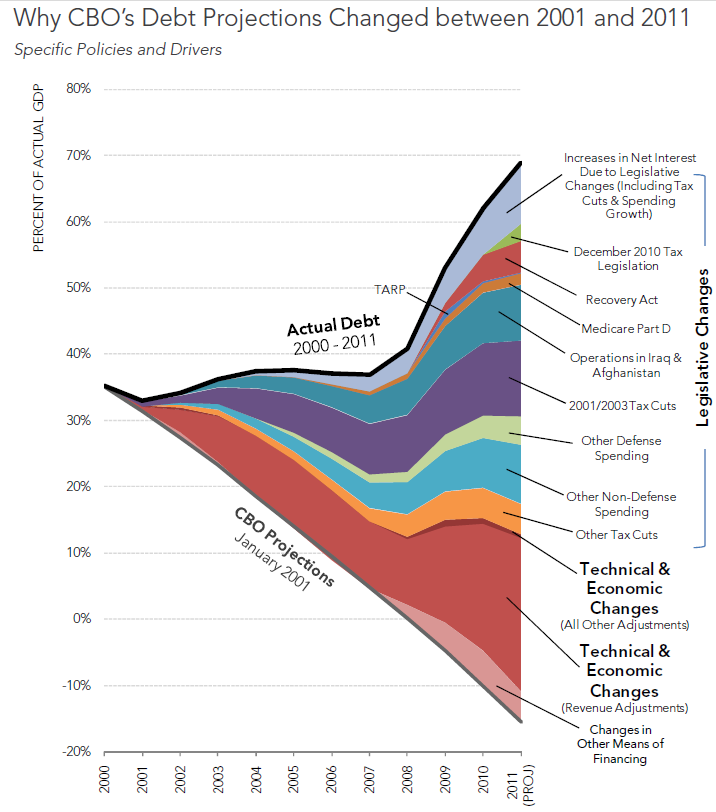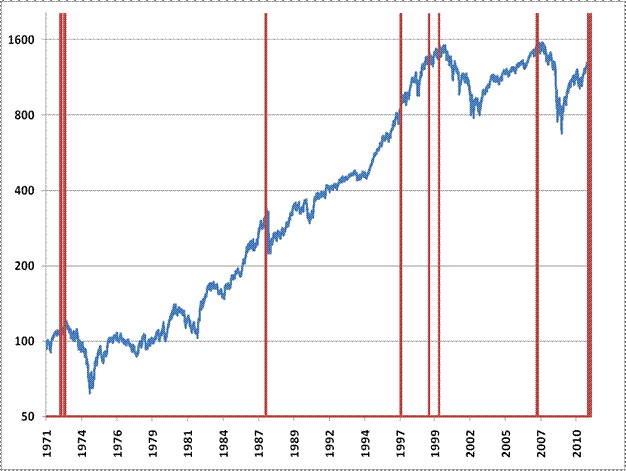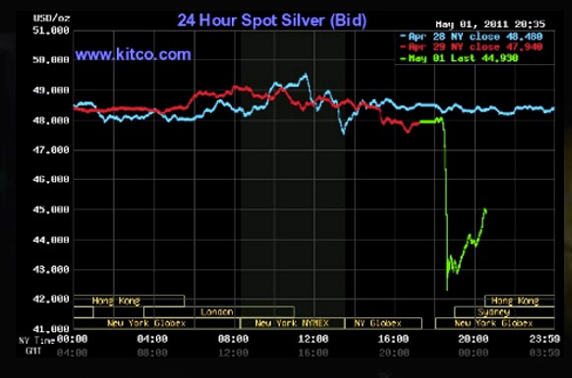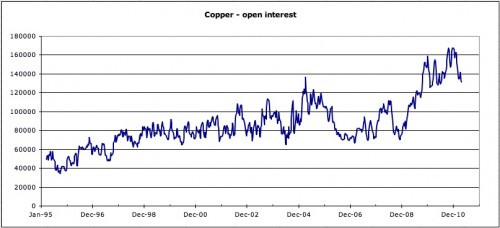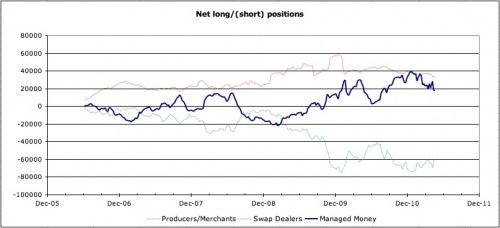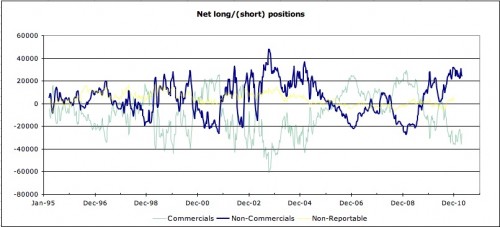B
y: Andre_Gratian
Very Long-term trend –he continuing strength in the indices is causing me to question whether we are in a secular bear market or two consecutive bull/bear cycles. In any case, the very-long-term cycles are down and, if they make their lows when expected, there will be another steep and prolonged decline into 2014-16.
Long-term trend - In March 2009, the SPX began an upward move in the form of a bull market. Cycles and P&F projections point to a continuation of this trend for several more months.
SPX: Intermediate trend –The intermediate trend is still up. We are close to achieving our short-term projection and therefore, another short-term correction is near.
Analysis of the short-term trend is done on a daily basis with the help of hourly charts. It is an important adjunct to the analysis of daily and weekly charts which discusses the course of longer market trends.
Market Overview
Last week, some indices appear to have reached a critical time frame. The dollar may have come to the end of its intermediate decline in what appears to be a selling climax characterized by the heaviest selling volume in five months. Gold also displayed buying climax characteristics which could put an end to its rally and trigger a correction. Both indices exceeded the Point & Figure projections that I had given by a small margin.
Equity indices, or the other hand, do not seem to be as vulnerable yet to an important reversal, but a short-term correction could come as early as Monday. Both the SPX and QQQ are severely overbought on the short-term, with extensive deceleration in their momentum indicators and substantial divergence showing in the breadth oscillators. Combine that with a minor cycle bottoming over the next couple of days, and you have a high probability recipe for a near-term correction. The SPX, however, has not reached its target for this phase of the move, and this may turn out to be only a breather before climbing the next few points to fill its P&F projection of 1370.
Once it gets to that higher level, the index should have a longer and deeper projection, but it is possible that it will still be short of an intermediate peak by some 60 or 70 points.
During the past two weeks, equity indices have been exceptionally strong, only pausing at each phase projection for a few hours in a very shallow consolidation before moving on to the next one. This is clearly illustrated on the hourly chart which we will analyze later on.
Chart Analysis
Let's first refresh our perspective about the bigger picture, starting with the SPX Weekly Chart.
The green channel represents the bull market which started in March, 2009 after two major cycles (6-yr & 7-yr) had made their lows. These two cycles were primarily responsible for the bear market and all its financial accoutrements. They are also the cause of the impetus behind the current bull market, which will end when they run out of steam and turn down. Then, unfortunately for those who are unprepared, the next economic dirge will play again as we have decline (probably severe) into the lows of the 40-yr and 120-yr cycles due in 2014-2016.
It is not possible to tell exactly when the bull market top will occur. There are some cycles just ahead of us which should pull down the indices into the end of the year. If you look at the indicator at the bottom of the chart, it is telling us that the current intermediate advance may not have much more of a run.
The negative divergence which shows in the indicator as the market is making new highs is awesome. Only this week, is it trying to break out of its down trend by crossing over. If the next intermediate correction is not too severe, we should be able to make a new bull market high into 2012 before the final plunge begins. As long as we stay within the confines of the green channel, we are practically assured of another attempt at making a new high.
Incidentally, we'll get plenty of warning for the end of the intermediate phase from the action of the daily chart. As we will see next, it is not close to giving a sell signal.
We'll now analyze the Daily Chart.
Last week, the SPX made a recovery high to 1364.56, after it broke out of a Head & Shoulders consolidation pattern. This is likely to produce an eventual move to a minimum of 1424 (using the conventional H&S projection method), and since there are previously established P&F projections to (ca)1435, they reinforce the odds of moving higher after correcting.
There are probably two consolidations directly ahead of us. The first could start Monday and be of a minor degree. The next one, after the SPX reaches its target of (ca)1370 (for the high of the rally from 1295) should be a little more substantial, but still moderate, perhaps fulfilling the retracement to the neckline which normally occurs after a break out from a H&S pattern. It is not until we get to the 1400s that we could end the intermediate trend -- represented on the chart by the blue channel.
The top indicator, which evaluates price momentum, is as overbought as can be at a reading of 100, and is beginning to go flat - since it can't go any higher. The breadth indicator, below, is telling us that we are on the verge of a correction. It is just about ready to give a sell signal. This combination could trigger a retracement at any time.
All buy and sell signals in the daily chart are anticipated in the Hourly Chart, so we'll turn to it next.
In the first advance from 1249, indicators gave a sell signal several days before the index finally broke down. We don't have quite the same pattern, here, but the loss of momentum and the negative divergence which show in the indicators are suggesting that a reversal could be imminent. The minor cycle which is scheduled to bottom on Monday or Tuesday normally does not have much effect on the market but considering the vulnerability of the index position, it could trigger a sell signal as early as Monday.
There are some factors which may prolong the consolidation by a couple of days, but the SPX is not expected to remain in a corrective mode very long before moving on to the 1370 target zone.
The base from which the projection was made is marked in light green on the chart. Also shown are the various interim targets. Note how there was only a pause of a few hours at each one before continuing the rally.
The move from 1249 has now formed a wider channel which may remain valid until the end of the intermediate trend.
Projections
In the SPX, 1334 was the most conservative P&F projection from the base that was established after the 1249 reversal. The re-accumulation pattern formed four distinct projection levels with the second one giving us a target of 1370. The highest one targets a level just above the H&S projection of 1424.
Cycles
After the minor cycle that is making its low early next week, the 14-15-wk top to top cycle which has been very regular since the March 2009 low could bring an end to the intermediate trend which started at 1011. If on schedule and still active, it should top around the third week of May.
Breadth
The NYSE Summation Index (courtesy of StockCharts.com) has risen along with the market, but remains under its former high while the indices have exceeded theirs. This is a sign of negative divergence, but as long as this index remains positive, the intermediate trend is not in trouble.
Sentiment
The level of the long-term indicator of the SentimenTrader (below, courtesy of same) has dropped a little from where it was two weeks ago. Since the market has rallied during that time, it's a normal adjustment and does not forebode a significant increase of market risk.
Dollar index
Last week, the UUP (dollar ETF) dropped sharply into its P&F projection of 21 in what appeared to be a mini-climax at the end of the second leg of a decline from late November. Giving it some credibility was a sharp increase in volume at the low.
The projection was made from a one half point P&F chart, and since the price remained well above 20.50, the projection has not been surpassed. This, combined with the mini-climactic action, is giving the index a fair chance of reversing from here, especially since the P&F projection was complemented by a Fibonacci target of 1.618 times the length of the last up-wave.
In addition to these potentially positive factors, there are two more: First, the index stayed well above the lows of both of its descending channels, and second, it stopped at a support level created by the junction of three valid internal trend lines.
It is too soon to determine whether this will become an important low, or just a blip - assuming it reverses at all! For a significant reversal, the index will have to overcome both descending channel trend lines and get past its 200-DMA which stopped it in its tracks twice, previously. This process would consume some time, and it is likely that the index would therefore be engaged in base building for a while.
The dollar index had a target of 74. It went beyond it to 73. In a climactic terminal move, this is acceptable. For a bona fide reversal, it will have to start pulling away from its low right away.
The only fly in the ointment is that the low was made without any trace of positive divergence!!!
Gold
Gold is exhibiting the climactic symptoms of the dollar, but in reverse. It is also in an area which had been predetermined by Fibonacci projections and P&F counts from the massive Head & Shoulders base which formed after the price of gold hit its November 2008 low. I emphasize "counts", because there are several that can be taken from that level.
Below, there are two charts of GLD, the gold ETF. The first shows the H&S base and projections only, and the second is GLD to-date. There is usually more than one level from which a count can be taken after a base has formed. The counting guide lines tell you to start with the most conservative one and let the stock or index let you know if it wants to go higher.
In the case of the GLD base which is shown below, there are three levels from which projections can be made. They are the 84, 86, and 93 levels and are represented on the chart by different shades of green. The most conservative aspect of the base is at the 84 level, and the most conservative projection from that level is 145. You can stretch it to 148-150 (which is what I have done) but that becomes dubious. If the index moves beyond that point, you have to start looking to the count across the 86 line for guidance.
The 86 level offers much higher potentials -- all the way to a maximum projection of 212-219. Since GLD has now exceeded the projections provided by the conservative base count at 84, we should now switch our attention to the potential presented by the next higher level of 86.
The minimum count from that level is taken to the price low, and it gives us a projection to 139 (which is also a phase count taken across the 84 base). You can see on the second GLD chart, below, that there was some selling at 139 before the index was able to move higher.
Now that it has, we are entitled to move across to the next phase, and that gives us a projection to 154-156
On the second chart, I have marked the re-accumulation base that was formed as a result of the 139 resistance and I have come up with a count across that base to 153-154, with a dubious 156.
On Friday, GLD touched 153. We should soon know if it intends to pause there and correct, or if it intends to move higher, first. The indicator is very close to giving a sell signal but, until it does, we have to let the index tell us its intentions. The next two projection phases could take us to 159 and 161.
Oil
Last week, crude oil crept up a little closer to its 115 target. The WTIC chart is courtesy of StockCharts.com.
Summary
I have provided extensive analyses of the dollar and gold, because both appear to be reaching a reversal point and readying to enter a corrective phase.
SPX may also be ready for a correction, but only near-term. It has a projection to about 1370 before this phase of the uptrend comes to an end.
